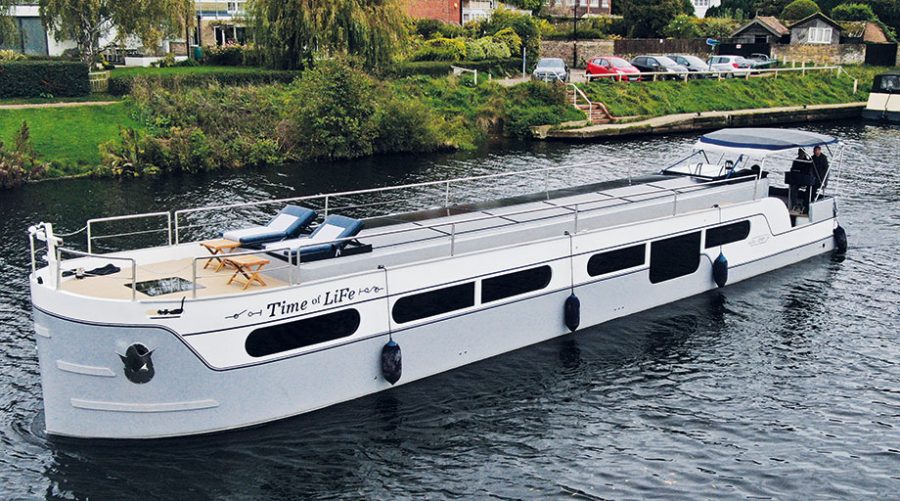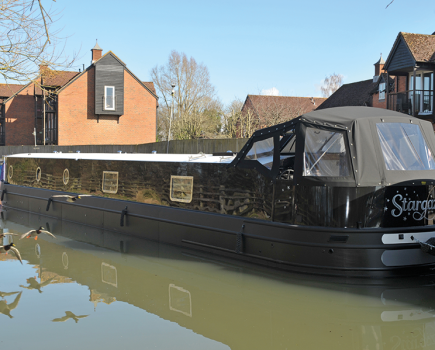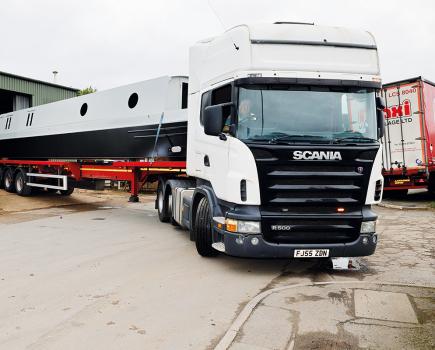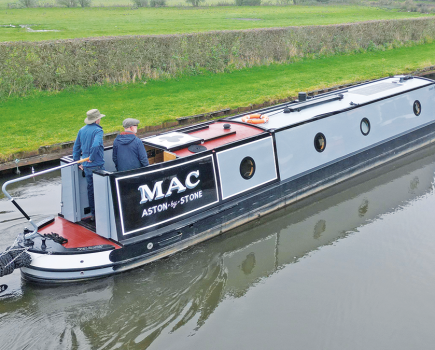This is definitely not your average craft, and so we simply couldn’t turn down the opportunity to take a closer look and give her a test run.
Words by Adam Porters | Pictures by Andy Annable
If I asked you to cast your mind back to the Crick Boat Show, you could be forgiven for thinking that it was just too long ago to properly remember what happened. After all, a lot has happened in the meantime – we’ve had a new monarch, two new prime ministers and at least three chancellors. Taxes have been raised, lowered, scrapped and unscrapped. There’s been a heatwave and a drought, and parts of the canal network have been closed due to lack of water.
And yet, the Crick show was less than six months ago. In case you’ve forgotten, the winner of the vote for the favourite widebeam boat – voted by visitors to the show – was Time of LiFe by Finesse, which we promised we’d take a closer look at. It’s taken a while to deliver on that promise because we’ve been waiting for the boat to take up residence on its home waters of the River Thames, where it’s fair to say it looks much more at home than in Crick Marina during the show. As we’ll see, this is an extraordinary boat, in terms of looks, fitout and technology.
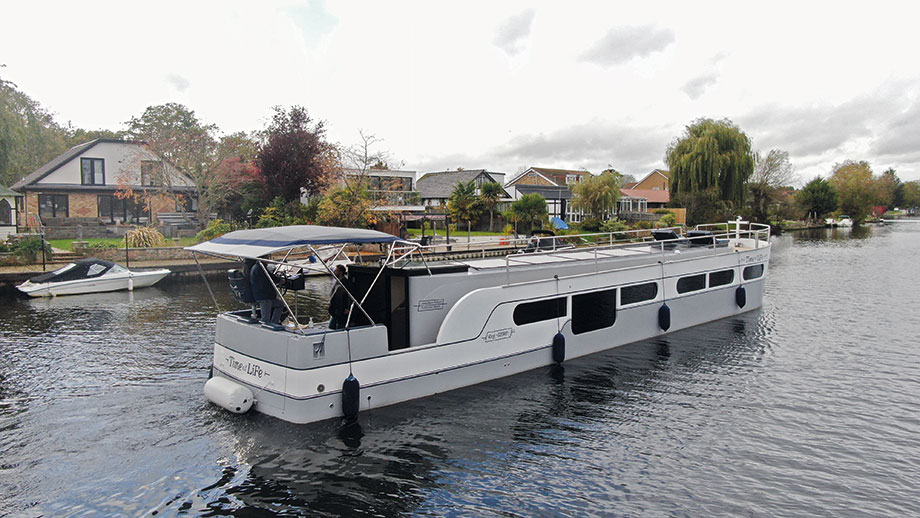
EXTERIOR
At the Crick Show, Time of LiFe appeared to dwarf all the boats around her, both narrowboats and the more conventional widebeams, but when you look at the actual figures, it’s not as huge a boat as it first appears. The shell is 65ft long and 12ft wide (with an extra couple of inches added to the width by the rubbing strakes). That’s no bigger than many a widebeam, and narrower than many – it’s just that the vertical sides and the high bow mean the boat has a bigger volume.
At 7ft 2in, its air draught is also less than you might think; the railings round the roof fold down and the stern deck is covered by a canopy rather than a wheelhouse. It’s a similar story under the water, as the draught is only 24 inches.
It’s still clearly a substantial boat, but its scale suits the Thames. The white parts of the colour scheme and the dark tinted windows with their curved shapes are all reminiscent of the fibreglass river cruisers which are so common here. But the addition of grey goes some way to reminding you that this is a steel boat not a plastic one. An important part of the colour scheme for the owners was that there’s no black above the waterline.
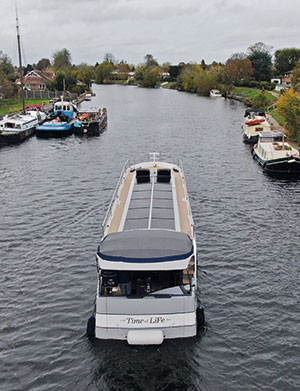 The design and build of the shell is all down to Jonathan Wilson. In fact, he constructed it virtually single-handed during lockdown when no other staff could go to work. The owners, who were in Sheffield to have some work done on their narrowboat, saw the shell and loved it so much they decided to buy it.
The design and build of the shell is all down to Jonathan Wilson. In fact, he constructed it virtually single-handed during lockdown when no other staff could go to work. The owners, who were in Sheffield to have some work done on their narrowboat, saw the shell and loved it so much they decided to buy it.
And there’s a lot to like. The bow, for example, has a definite point at the waterline, but softens to a curve at the top, meaning it has presence without looking frightening to oncoming traffic. And even though it’s big, it still looks sleek. More than anything, it looks like a proper boat.
The stern deck has seating built in. It’s already a large area, but can be made larger still: fold the seating away and press a button and the rear lowers hydraulically to the horizontal, to create something akin to a swimming platform. Move the table to the end and you have the perfect outdoor eating area.
There are no gunwales in the traditional sense. Instead, broad steps lead up from the stern deck on each side of the boat to the roof walk. A raised central section provides plenty of room for a massive array of solar panels. At the forward end, a couple of sun loungers are built into the roof, and you can walk across the glass skylight over the cabin below. In many ways, this roof terrace is more useable as a socialising and relaxing area than a well deck would be.
LAYOUT AND FITOUT
This is a reverse layout boat. Immediately inside the boat at the stern is a raised dining area. Beyond that is a huge saloon with an open plan galley. A corridor down one side of the boat leads past a second cabin, which doubles as an office, and a generous shower room. The main cabin is at the bow.
The fitout has all the elements we’ve come to expect from Finesse. It’s crisp, clean, sharp and immaculately put together. There’s colour, design flair and good ideas everywhere, with a few surprises thrown into the mix.
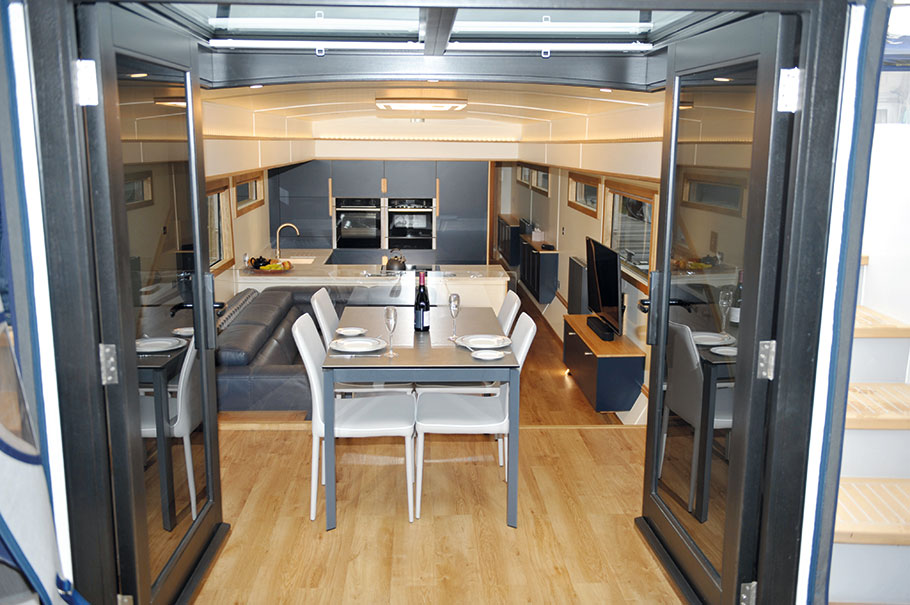
LIVING AREA
Full height glass doors lead from the stern deck into the boat, and there’s a glass ceiling here too. This part of the interior is slightly narrowed by the steps running up the outside of the boat, so it’s used as the dining area. It feels a bit like being on a stage, because the area is higher than the rest of the interior and separated by a glass partition – and you get a great view of the saloon and the galley, as well as the raised central part of the ceiling, which is washed with LED lighting.
The raised floor also houses the fresh water tanks which total 1,500 litres, as well as the loo holding tank, which is 800 litres.
The boat’s huge battery bank is also under here, across the back of the room. Access is through one of the under-stairs cupboards, although as the batteries have an expected life of 40 years, access shouldn’t be needed very often.
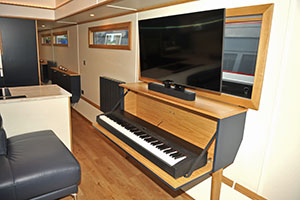 A couple of steps take you down into the saloon, from where you can access storage under the raised floor. The head height here is 8ft, making the whole space feel incredibly airy and spacious; it’s painted white, which adds to the feeling of space, with oak trim.
A couple of steps take you down into the saloon, from where you can access storage under the raised floor. The head height here is 8ft, making the whole space feel incredibly airy and spacious; it’s painted white, which adds to the feeling of space, with oak trim.
And while the windows are curvy on the outside, inside they have square corners, oak trim and built-in blinds. The idea was to frame each view like a piece of art – and it works. Sit at the dining table and you’re at just the right height for views through the biggest windows. The narrower windows give you tempting glimpses.
You also get a hint about the underwater shape of the boat once you’re in the saloon, because you can see the shape of the chines in the lower foot or so of the external walls.
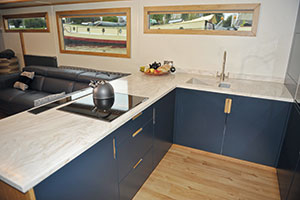 There’s a huge, comfortable L-shaped sofa, with a floating tv unit opposite. The whole unit rises electrically, staying perilously close to the wall the whole time, then has fold out legs and a drop-down front to reveal an electric piano. It’s a very clever piece of space-saving engineering.
There’s a huge, comfortable L-shaped sofa, with a floating tv unit opposite. The whole unit rises electrically, staying perilously close to the wall the whole time, then has fold out legs and a drop-down front to reveal an electric piano. It’s a very clever piece of space-saving engineering.
The galley looks like one you’d find in a luxury flat. Many Finesse skills are on show here, because the galley doors are all spray painted in-house, in a dark blue colour which is used on all the furniture in this area. The Corian worktops are also made in-house, complete with a moulded sink and a routed drainer. There are Neff ovens and a warming drawer, a Neff fridge and freezer and a Smeg washing machine. There’s a John Lewis induction hob and a Klarstein extractor that rises out of the worktop. To save having smaller appliances on show, there’s a special cupboard with a shelf that pulls out on runners where the coffee machine and toaster live.
SECOND CABIN
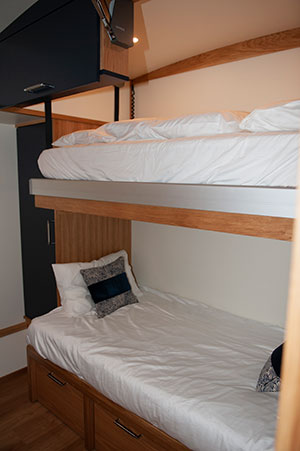 A corridor with narrow windows and storage cupboards runs down one side of the boat, leading first to the second cabin, which doubles as an office. A large unit on one side houses a bed which extends to a double, with drawers underneath and a large wardrobe at the foot. But there’s more, because a single bunk lowers electrically from ceiling height. There’s also a cubby hole up there, complete with charging sockets.
A corridor with narrow windows and storage cupboards runs down one side of the boat, leading first to the second cabin, which doubles as an office. A large unit on one side houses a bed which extends to a double, with drawers underneath and a large wardrobe at the foot. But there’s more, because a single bunk lowers electrically from ceiling height. There’s also a cubby hole up there, complete with charging sockets.
On the other side of the room is a desk with storage. The large screen is both a computer monitor and a tv. Underneath the desk is a printer, housed in what would otherwise be a dead corner in the galley. It pulls out on runners, to make it accessible. There’s more clever use of space with some cupboards at ceiling height, making use of the ceiling void.
MAIN CABIN
The main cabin is at the bow and is big enough to have a king size bed. There’s a feature headboard which extends onto the ceiling and has LED illumination around its frame. You can change the colour temperature of the lights to give different moods. On one side is a bedside cabinet; on the other side is the door into the room – so there’s a neat little shelf at bedside height on the back of the door. There are also drawers in the bed base.
There are narrow windows, at eye level when you’re standing up, so offering a great deal of privacy even when the built-in blinds are open. There’s plenty of light thanks to a skylight; this also has a blind and opens electrically – although there’s also a manual over-ride in case it needs to be used as an escape hatch. At the bow are three large wardrobes with drawers underneath, giving plenty of space for clothes. All in all, this is a very calm, relaxing space.
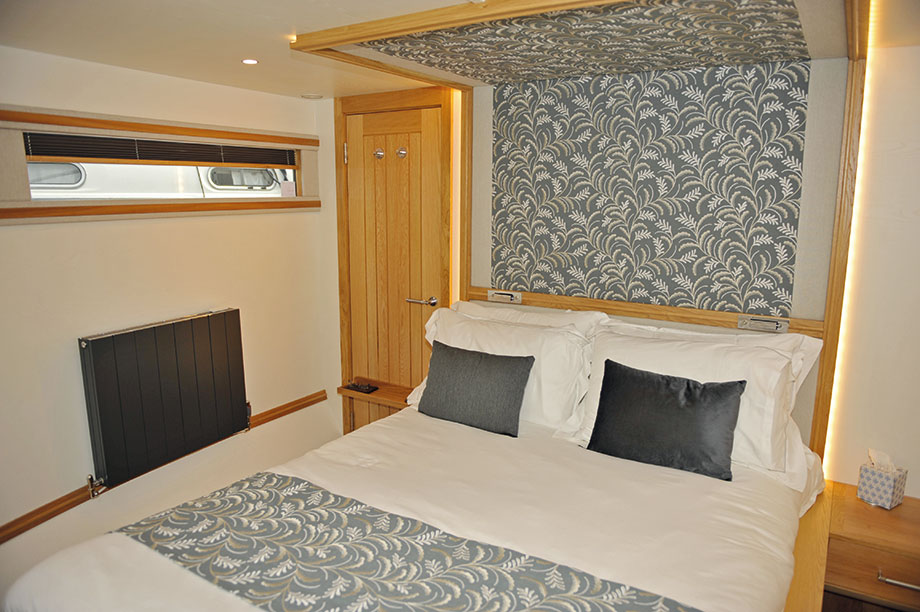
SHOWER ROOM
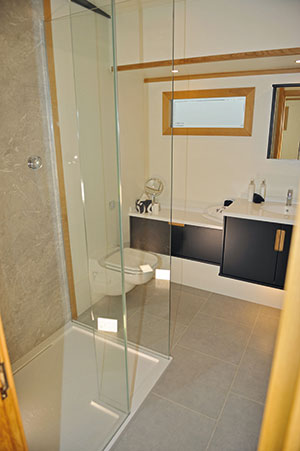 This is another spacious and well-appointed room. The glass shower cubicle is large and has a Corian tray and soap dish, and there’s a choice of two shower heads.
This is another spacious and well-appointed room. The glass shower cubicle is large and has a Corian tray and soap dish, and there’s a choice of two shower heads.
The basin sits in a floating unit which offers some storage. There’s also a drawer alongside and a mirrored vanity unit above. On one wall there’s a tall towel rail along with some more ceiling-level cupboards. The loo is a Vetus macerating unit, and the floor is Karndean in a stone effect with a grout line.
TECHNICAL
This is an electric propulsion boat, with a huge bank of Lithium-iron batteries (known by the shorthand, LiFe, hence the name of the boat), a significant solar array and a diesel generator.
One issue with such a system is that there is an almost infinite number of combinations of electric motors, batteries and generators – and it can be difficult to ensure they all work together in exactly the best way. To address this, Finesse has come up with its own system consisting of a motor which they put together themselves, and everything is linked by their own control system.
The electric motor is a 48 volt Permanent Magnet AC type, rated at 30kw continuous. It has no belts, no gears and needs no maintenance, and comes with a 10 year warranty. The battery bank needs to be large to provide power for propulsion and all the electric equipment on board. It amounts to 50kwh at 48 volts; to give you some idea how that compares with a conventional 12 volt set up, the equivalent would be about 4000Ah (although as you should only discharge lead acid batteries to about 50 per cent while LiFe batteries can be discharged almost to nothing, you’d actually need 8000Ah of lead acids to provide the same amount of power). There are a couple of ways of charging this battery bank.
There’s a 4kw solar array on the roof, wired in such a way so that even if one panel is in the shade, the rest won’t be dragged down. There’s also a 13kva Kohler generator, which can be started remotely so you can keep the batteries topped up even if you’re away from the boat. The boat can also be plugged into shore power – but you can also remotely control whether any electricity is actually supplied, so that the free solar energy can be maximised. A Victron 15kw inverter provides a 240 volt supply.
Central heating and hot water comes from a pressure jet boiler, but certainly in the summer months it’s likely that it won’t be used much. That’s because hot water can be made via an electric immersion heater which can make the most of solar power, and running the generator also heats the water.
Air conditioning was a particular requirement of the owners, who’ve had several holidays on their narrowboat in heatwaves where the interior got hotter and hotter. The system on this boat uses a heat pump, so while it provides cooling in the summer, it can also produce warm air in the winter.
ON THE WATER
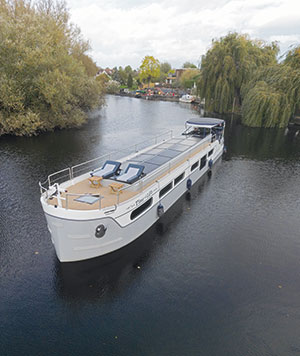 Time of LiFe is steered with a wheel rather than a tiller, from an elevated position on one side of the stern deck. If you prefer standing to sitting down, the seat flips up giving you somewhere to lean.
Time of LiFe is steered with a wheel rather than a tiller, from an elevated position on one side of the stern deck. If you prefer standing to sitting down, the seat flips up giving you somewhere to lean.
The binnacle, which is made in-house of Corian, carries all the switches and dials, which include an indicator of which way the rudder is pointing. There’s a housing for a tablet, so you can have a moving map showing where you are, and the owner has put a camera at the bow, with the picture showing on another screen.
The boat handles extraordinarily well – which is good because the route from its marina berth along a Thames backwater onto the river itself is very twisty. We also did a U-turn on the river with minimal fuss. There’s definitely a knack to wheel steering, but it takes only a little while to get used to it.
The whole reason the owners wanted electric propulsion was for the peace and tranquillity – and it certainly scores on that measure. At low speeds, there’s almost no sound at all; even with a bit more power, the sound of the water along the boat and round the prop is louder than the motor.
The bow thruster is a brushless model by Vetus, which can run in a graduated way. You can also lock it on, as it’s happy running for a long period of time if necessary. Access to the engine hole is easy. The deck board lifts at the press of a button, on a hydraulic ram.
CONCLUSION
Whichever way you look at it, this is a pretty special boat. From the exterior styling to the stylish interior, there’s a lot to appreciate. Then there’s the top notch electric propulsion system, and the fact that it’s loaded with technology and clever ideas.
Of course a boat of this size and quality doesn’t come cheap. Finesse says a boat similar to this would start at £350,000 – but that wouldn’t include the electric propulsion and its associated LiFe batteries and so on, so this boat will have cost considerably more. But if you were planning to live on board rather than just use it for holidays, a major plus point to the gunwale-free design is that the boat easily qualifies for zero VAT.
But perhaps the most appealing thing about Time of LiFe is that it’s a proper boat. The owners have already travelled extensively on the Thames, and are thinking about taking it to France for a few years to explore the waterways there. It’s far more than just a floating luxury apartment where you might sit and watch all the news we’ve had recently; on this boat you could easily escape and ignore the outside world completely.
Specification
Total price in excess of £350,000
LENGTH: 65ft
BEAM: 12ft 2in
SHELL: Jonathan Wilson (contact via Finesse)
STYLE: River cruiser
LAYOUT: Reverse
BERTHS: 2+2+1
FIT-OUT: Painted panels and oak
ELECTRIC MOTOR: 30kw PMAC (www.finesseboats.co.uk)
GENERATOR: Kohler 13kva (www.kohlerpower.com)
BOW THRUSTER: Vetus brushless (www.vetus.com)
INVERTER: Victron 48 15kva (www.victronenergy.com)
CONTACT: Finesse Boats, Victoria Boatyard, Sussex Street, Sheffield S4 7YY
T: 01143 270404
E: sales@finesseboats.co.uk
W: www.finesseboats.co.uk
Watch a tour of Time of LiFe at the Canal Boat Facebook page
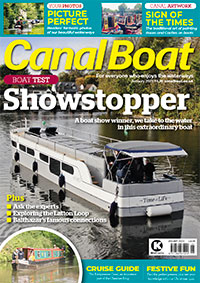 As featured in the January 2023 issue of Canal Boat. Buy the issue here
As featured in the January 2023 issue of Canal Boat. Buy the issue here

